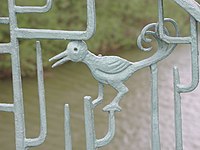Fennpfuhl Bridge
Coordinates: 52 ° 31 ′ 47 " N , 13 ° 28 ′ 31" E
| Fennpfuhl Bridge | ||
|---|---|---|
| Bridge seen from the south | ||
| use | pedestrian | |
| Convicted | the enlarged Fennpfuhl | |
| Crossing of | Waters | |
| place |
Berlin district of Lichtenberg and Fennpfuhl |
|
| overall length | about 30 m | |
| width | 4.50 m | |
| Longest span | 16 m | |
| start of building | around 1977 | |
| completion | around 1979 | |
| location | ||
|
|
||
The Fennpfuhlbrücke is a pedestrian bridge over the newly created waterway connection between Fennpfuhl and Langpfuhl in the Berlin-Fennpfuhl district of Berlin's Lichtenberg district in the middle of the Fennpfuhl Park . It provides access to the district center Anton-Saefkow-Platz (first called the social center ) and the Volksporthalle from the east, from the Weißenseer Weg area .
Emergence
The Fennpfuhlbrücke was part of the planning for the years 1970–1977 for the construction and completion of the then residential area Lichtenberg-Nord including the residential park . The plan included a pedestrian bridge to cross the six-lane street Weißenseer Weg (between 1976 and 1992 Ho Chi Minh Street ), but this was never built (as shown on enamel information boards in the residential area and in a magazine) . Both bridges should form a unit and invite you to stroll through the park.
The bridge actually built between 1978 and 1979 spans today's Fennpfuhl, which was created by merging the former Fennpfuhl with the Langpfuhl; the age of both waters is given as around 20,000 years. In an internal study from 1970, the merger was not planned, it is referred to as "the two lakes". (Between 1925 and 1953 there was an official 250 m long oval speed skating rink on the old Fennpfuhl , on which the Berlin championships were held in February 1951.)
The design of the Fennpfuhl Bridge comes from an East Berlin engineering office; it was built as a simple steel composite bridge from prefabricated parts. The bridge is covered with a concrete walkway, five upright concrete girders serve as the supporting structure and the entire construction rests on solid concrete blocks.
Oval decorative elements are incorporated into the wrought-iron railing, depicting various birds and plants, which were made by Adam Kurtz in 1986 in the Weißensee art forge.
The same decoration was also made in 1986 on a small seat on the north side of the Fennpfuhl for a bank boundary, namely as a decorative design of the fresh water inlet and the retaining wall at the Langpfuhl and simplified on the bank in front of the former restaurant "Seeterrassen".
Other bridges not yet realized in the Berlin-Fennpfuhl area
A bridge that was to cross the enlarged Fennpfuhl, which was expanded to include an outdoor pool, and reach as far as Karl-Lade-Strasse, never got beyond the conception stage.
As a large pedestrian overpass, similar to the one outlined above for Weißenseer Weg, a bridge was also to be built over the six-lane Landsberger Allee (former Leninallee), from the open space between the twin high-rise and the former grocery store (now the location of the Castello) on the north side the avenue to the boulevard on Anton-Saefkow-Platz, as also previously existing information boards and the following statement show: "Works of fine and applied arts (should) be set up from the pedestrian bridge Leninallee to Kaskade Fennpfuhl".
Individual evidence
- ↑ Neue Berliner Illustrierte No. 21/1976
- ^ Material from BVV Lichtenberg in the archive of the Lichtenberg local history museum in the town hall
- ^ Website of the German Fast Run Society
- ↑ Explanation of jewelry design based on a metal plate attached to the railing
- ^ A b Art design concept, Berlin-Lichtenberg district, residential area III, Leninallee / Ho-Chi-Minh-Strasse, 4th construction phase, social area - from April 25, 1978; unpublished
Sources and web links
- 5 projects from the Senate's funding program on the subject of Fennpfuhl ; accessed on January 8, 2016.
- Berliner Zeitung from June 10, 1977.
- Dieter Rühle : Open space design on Anton-Saefkow-Platz in Berlin , pages 30–35; Architecture magazine No. 10, 1990.




